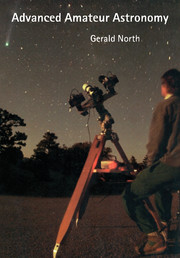Book contents
- Frontmatter
- Contents
- Preface to the second edition
- Preface to the first edition
- Acknowledgements
- 1 Telescope optics
- 2 Atmosphere, seeing, magnification and eyepieces
- 3 Telescope hardware and adjustments
- 4 Astrophotography with the camera
- 5 Astrophotography through the telescope
- 6 Electronic imaging
- 7 The Moon
- 8 The terrestrial planets
- 9 The gas-giant planets
- 10 Asteroids, comets, meteors and aurorae
- 11 The Sun
- 12 Variable stars and novae
- 13 Methods of photometry
- 14 Double stars, star clusters, nebulae, galaxies and supernovae
- 15 Spectroscopy
- 16 Radio astronomy
- 17 Further information
- Appendix: Useful formulae
- Index
4 - Astrophotography with the camera
Published online by Cambridge University Press: 04 August 2010
- Frontmatter
- Contents
- Preface to the second edition
- Preface to the first edition
- Acknowledgements
- 1 Telescope optics
- 2 Atmosphere, seeing, magnification and eyepieces
- 3 Telescope hardware and adjustments
- 4 Astrophotography with the camera
- 5 Astrophotography through the telescope
- 6 Electronic imaging
- 7 The Moon
- 8 The terrestrial planets
- 9 The gas-giant planets
- 10 Asteroids, comets, meteors and aurorae
- 11 The Sun
- 12 Variable stars and novae
- 13 Methods of photometry
- 14 Double stars, star clusters, nebulae, galaxies and supernovae
- 15 Spectroscopy
- 16 Radio astronomy
- 17 Further information
- Appendix: Useful formulae
- Index
Summary
Astrophotography is a natural extension of the visual techniques used by amateur astronomers. However, many observers are put off by the impression that it is a particularly difficult skill to master. The imagined expense and complexity of the required equipment is another deterrent. In fact, with modern films, a home-doer can fairly easily obtain impressive and very useful results using very limited equipment.
Basic equipment
A start can be made with a low cost camera mounted on a tripod and operated by a short cable-release. Cameras come in a variety of types. On some the lenses are permanently fixed in position. Other cameras have lenses which are removable. They either have screw or bayonet fittings to allow the attachment of different lenses in place of the camera's ‘standard’ lens. Basic astrophotography can be carried out with a camera which is fitted with a fixed lens, though having the facility to remove it is certainly useful for more advanced work. Single-lens reflex (SLR) cameras, having an optical system which allows the operator to see what the camera lens is seeing, are especially convenient and are to be recommended.
The camera will have a range of available shutter speeds. Some have shutter speeds as fast as 1/2000 second but the astrophotographer will find that he/she rarely uses exposures even as short as 1/500 second. Even with a very sensitive film in the camera, the low intensity of light received from most atronomical objects warrents the use of much longer exposures.
- Type
- Chapter
- Information
- Advanced Amateur Astronomy , pp. 79 - 104Publisher: Cambridge University PressPrint publication year: 1997



